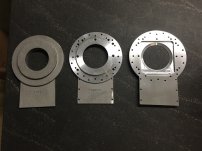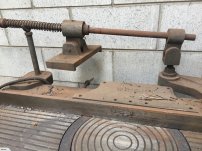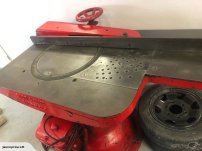I have some particularly nasty castings that are not cooperating. Mat is 356-t6, they are thin an flimsy. Part was originally made in the 1940’s, and they at the time made a lot of them with dedicated tooling . Runs are 25 pcs. See pics.
It is my contention that these were probably put in a jig, cased in lead or something like it and Blanchard ground , this makes for one side flat.
Initially, I chuck these up face the front and bore a hole in them for a press fit plug. The casting is held in soft jaws which are lined with 90 durometer urethane. The jaws have a hole bored that the pressed plug gets clamped on and the urethane along the edges clamps the irregular part. The right side has eccentric knife edged screws which bite into the casting. Issue one, it of course chatters and when unclamped part is bowed, issue 2 , because this thing can float, I’m getting poor hole location. The square end is only 1/8 thick. Suggestions on how to better hold this thin irregular shape, or how it may have been originally done? This was first made 25 years before I was born, things were done differently then. Because it is so thin, things like mighty bites , I don’t see working. If the big side was known flat and ground to size, then it could be mounted to a plate with small clamps. Order of present opps are bottom and holes, in cnc lathe chucked from id bore and shoulder turned, flipped on lathe , mounted in pie jaws and the spherical radius cut, middle bores to size. Lots of clamping on a flimsy piece of aluminum.
Suggestions ?
It is my contention that these were probably put in a jig, cased in lead or something like it and Blanchard ground , this makes for one side flat.
Initially, I chuck these up face the front and bore a hole in them for a press fit plug. The casting is held in soft jaws which are lined with 90 durometer urethane. The jaws have a hole bored that the pressed plug gets clamped on and the urethane along the edges clamps the irregular part. The right side has eccentric knife edged screws which bite into the casting. Issue one, it of course chatters and when unclamped part is bowed, issue 2 , because this thing can float, I’m getting poor hole location. The square end is only 1/8 thick. Suggestions on how to better hold this thin irregular shape, or how it may have been originally done? This was first made 25 years before I was born, things were done differently then. Because it is so thin, things like mighty bites , I don’t see working. If the big side was known flat and ground to size, then it could be mounted to a plate with small clamps. Order of present opps are bottom and holes, in cnc lathe chucked from id bore and shoulder turned, flipped on lathe , mounted in pie jaws and the spherical radius cut, middle bores to size. Lots of clamping on a flimsy piece of aluminum.
Suggestions ?












